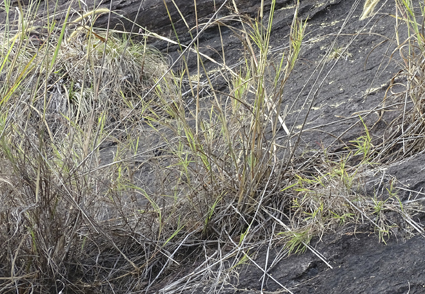Abstract
Themeda saxicola is an endemic perennial grass rediscovered after laps of 67 years from the Raisili hill (type locality) and Deomali hill, from the Eastern Ghats in the Koraput district of Odisha. The detailed description along with colour photographs of the habitats, habit and floral parts are provided for easy identification of the species. In addition, distribution map and IUCN threat category assessment are also provided.
References
<p>Bachman, S., Moat, J., Hill, A.W., de la Torre, J. and Scott, B. (2011) Supporting Red List threat assessments with GeoCAT: geospatial conservation assessment tool.<em> In: </em>Smith, V. & Penev, L. (Eds.) e-Infrastructures for data publishing in biodiversity science. <em>ZooKeys</em> 150: 117–126. (Version BETA)<sup>*</sup></p>
<p>Bor, N.L. (1951) Some new species of Indian grasses. <em>Kew Bulletin </em>1951: 451–452. https://dx.doi.org/10.2307/4120594</p>
<p>Candolle, A.P. de (1836) <em>Prodromus Systematis Naturalis Regni Vegetabilis</em>, vol. 5. Treuttel & Würtz, Paris, 181 pp.</p>
<p>Chemisquy, M.A., Giussani, L.M., Scataglini, M.A., Kellogg, E.A. & Morrone, O. (2010) Phylogenetic studies favour the unification of <em>Pennisetum</em>, <em>Cenchrus</em> and <em>Odontelytrum</em> (Poaceae): a combined nuclear, plastid and morphological analysis, and nomenclatural combinations in <em>Cenchrus</em>. <em>Annals of Botany </em>106 (1): 107–130. https://doi.org/10.1093/aob/mcq090</p>
<p>Forsskal, P. (1775) <em>Flora of Aegyptiaco-Arabica. </em>Hauniae (Copenhagen): ex officina Molleri, 178 pp.</p>
<p>Hackel, E. (1889) Andropogoneae. <em>In: </em>Candolle, A.L.P.P. & Candolle, A.C.P. (Eds.) <em>Monographiae Phanerogamarum, </em>vol. 6. Sumptibus G. Masson, Paris, pp. 1–716.</p>
<p>IUCN (2022) The IUCN Red List of Threatened Species. Version 2021-3. IUCN Red List Unit, Cambridge U.K. Available from: https://www.iucnredlist.org (assessed 8 January 2022)</p>
<p>Kellogg, E.A., Abbott, J.R., Bawa, K.S., Gandhi, K.N., Kailash, B.R., Ganeshaiah, K.N., Shrestha, U.B. & Raven, P. (2020) Checklist of the grasses of India. <em>PhytoKeys</em> 163: 1–560. https://doi.org/10.3897/phytokeys.163.38393</p>
<p>King, R.M. & Robinson, H. (1970) Studies in the Eupatorieae (Compositae). XIX. New combinations in <em>Areratina</em>. <em>Phytologia</em> 19: 223. https://doi.org/10.5962/bhl.part.14771</p>
<p>Kuntze, C.E.O. (1891) <em>Revisio Generum Plantarum: vascularium omnium atque cellularium multarum secundum leges nomeclaturae internationales cum enumeratione plantarum exoticarum in itinere mundi collectarum. </em>Leipzig, 525 pp. https://doi.org/10.5962/bhl.title.124064</p>
<p>Linnaeus, C. (1759) <em>Systema Naturae Editio decima, reformata</em>. Stockholm, 1100 pp.</p>
<p>Linnaeus, C. (1753) <em>Species Plantarum </em>2. Salvius, Stockholm, 627 pp.</p>
<p>POWO (2021) Plants of the World Online. Facilitated by the Royal Botanic Gardens, Kew. Available from: http://www.plantsoftheworldonline.org/ (accessed 27 August 2021)</p>
<p>Roemer, J.J. & Schultes, J.A. (1817) Systema Vegetabilium 2. J.G. Cottae: Stuttgart, 964 pp.</p>
<p>Schumacher, H.C.F. (1827) <em>Beskrivelse af Guineeiske Planter som ere fundne af dankse Botanikere, især af Etatsraad Thonning ved F.C. Schumacher, Saerskilt aftrykt af det kongelige danske Videnskabers Selskabs Skrifter. </em>Kjöbenhavn, 44 pp. https://doi.org/10.5962/bhl.title.51454</p>
<p>Trinus, C.B.V. (1820) <em>Fundamenta Agrostographiae.</em> J. G. Heubner, Vienna, 167 pp.</p>
<p>Bor, N.L. (1951) Some new species of Indian grasses. <em>Kew Bulletin </em>1951: 451–452. https://dx.doi.org/10.2307/4120594</p>
<p>Candolle, A.P. de (1836) <em>Prodromus Systematis Naturalis Regni Vegetabilis</em>, vol. 5. Treuttel & Würtz, Paris, 181 pp.</p>
<p>Chemisquy, M.A., Giussani, L.M., Scataglini, M.A., Kellogg, E.A. & Morrone, O. (2010) Phylogenetic studies favour the unification of <em>Pennisetum</em>, <em>Cenchrus</em> and <em>Odontelytrum</em> (Poaceae): a combined nuclear, plastid and morphological analysis, and nomenclatural combinations in <em>Cenchrus</em>. <em>Annals of Botany </em>106 (1): 107–130. https://doi.org/10.1093/aob/mcq090</p>
<p>Forsskal, P. (1775) <em>Flora of Aegyptiaco-Arabica. </em>Hauniae (Copenhagen): ex officina Molleri, 178 pp.</p>
<p>Hackel, E. (1889) Andropogoneae. <em>In: </em>Candolle, A.L.P.P. & Candolle, A.C.P. (Eds.) <em>Monographiae Phanerogamarum, </em>vol. 6. Sumptibus G. Masson, Paris, pp. 1–716.</p>
<p>IUCN (2022) The IUCN Red List of Threatened Species. Version 2021-3. IUCN Red List Unit, Cambridge U.K. Available from: https://www.iucnredlist.org (assessed 8 January 2022)</p>
<p>Kellogg, E.A., Abbott, J.R., Bawa, K.S., Gandhi, K.N., Kailash, B.R., Ganeshaiah, K.N., Shrestha, U.B. & Raven, P. (2020) Checklist of the grasses of India. <em>PhytoKeys</em> 163: 1–560. https://doi.org/10.3897/phytokeys.163.38393</p>
<p>King, R.M. & Robinson, H. (1970) Studies in the Eupatorieae (Compositae). XIX. New combinations in <em>Areratina</em>. <em>Phytologia</em> 19: 223. https://doi.org/10.5962/bhl.part.14771</p>
<p>Kuntze, C.E.O. (1891) <em>Revisio Generum Plantarum: vascularium omnium atque cellularium multarum secundum leges nomeclaturae internationales cum enumeratione plantarum exoticarum in itinere mundi collectarum. </em>Leipzig, 525 pp. https://doi.org/10.5962/bhl.title.124064</p>
<p>Linnaeus, C. (1759) <em>Systema Naturae Editio decima, reformata</em>. Stockholm, 1100 pp.</p>
<p>Linnaeus, C. (1753) <em>Species Plantarum </em>2. Salvius, Stockholm, 627 pp.</p>
<p>POWO (2021) Plants of the World Online. Facilitated by the Royal Botanic Gardens, Kew. Available from: http://www.plantsoftheworldonline.org/ (accessed 27 August 2021)</p>
<p>Roemer, J.J. & Schultes, J.A. (1817) Systema Vegetabilium 2. J.G. Cottae: Stuttgart, 964 pp.</p>
<p>Schumacher, H.C.F. (1827) <em>Beskrivelse af Guineeiske Planter som ere fundne af dankse Botanikere, især af Etatsraad Thonning ved F.C. Schumacher, Saerskilt aftrykt af det kongelige danske Videnskabers Selskabs Skrifter. </em>Kjöbenhavn, 44 pp. https://doi.org/10.5962/bhl.title.51454</p>
<p>Trinus, C.B.V. (1820) <em>Fundamenta Agrostographiae.</em> J. G. Heubner, Vienna, 167 pp.</p>


